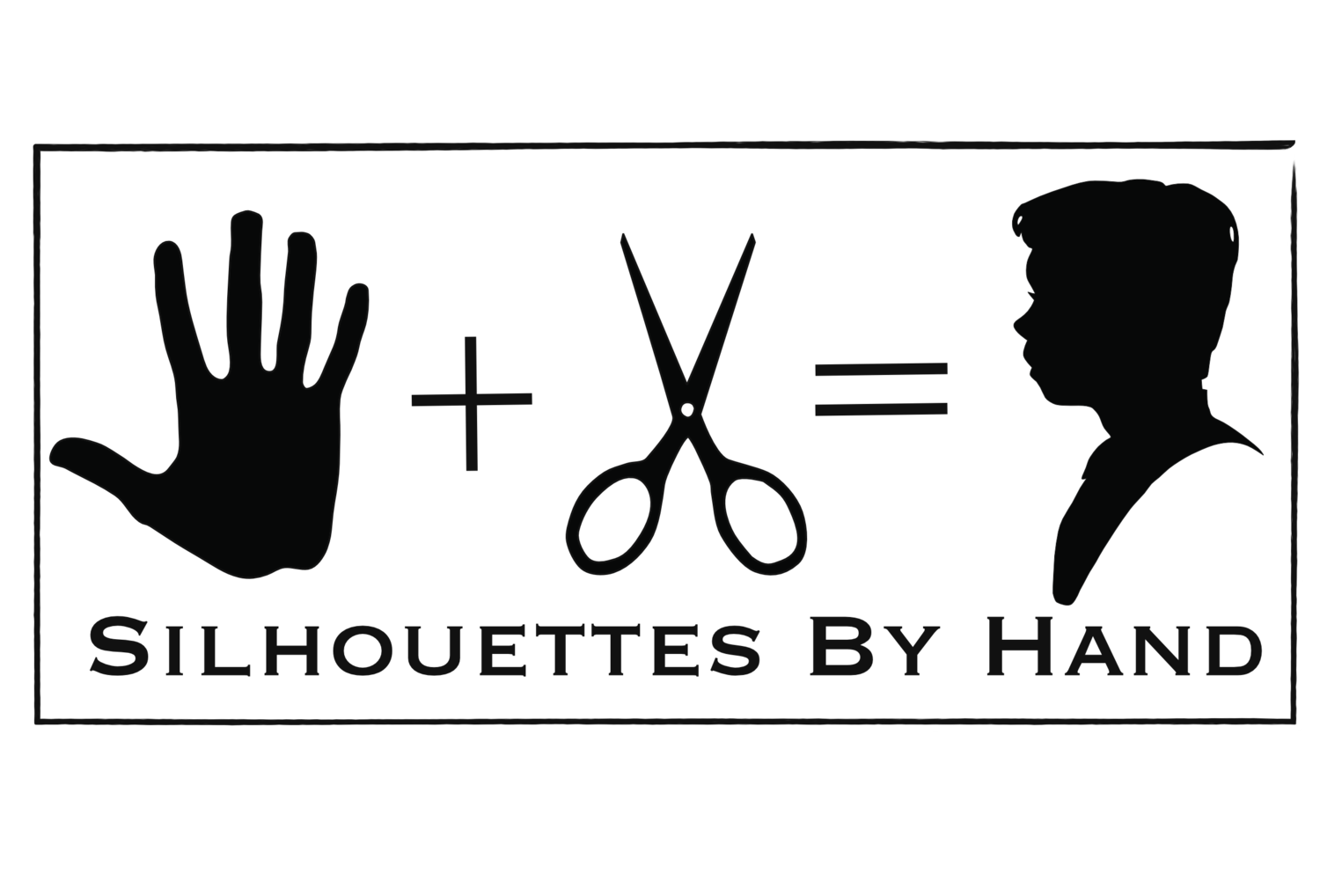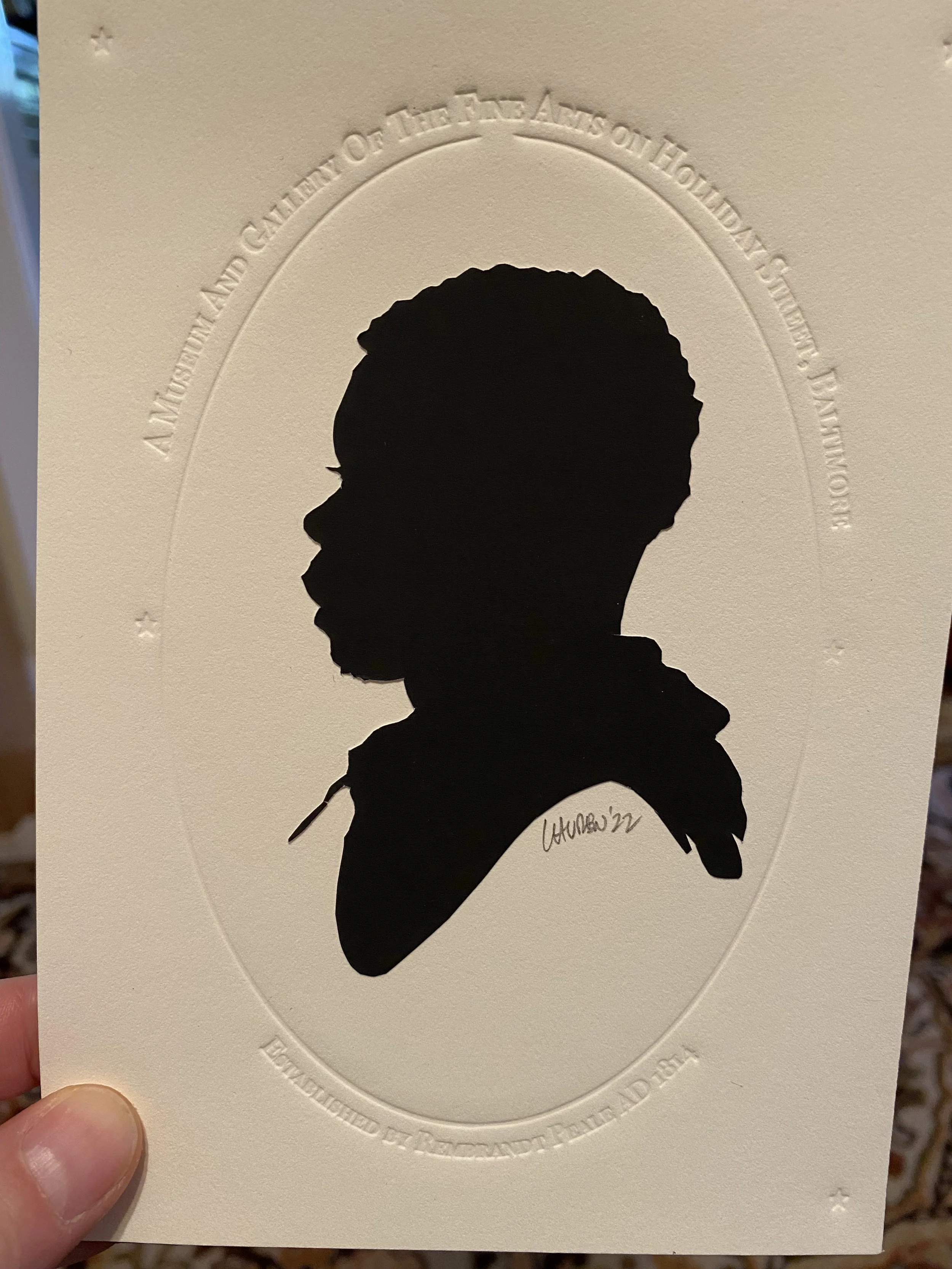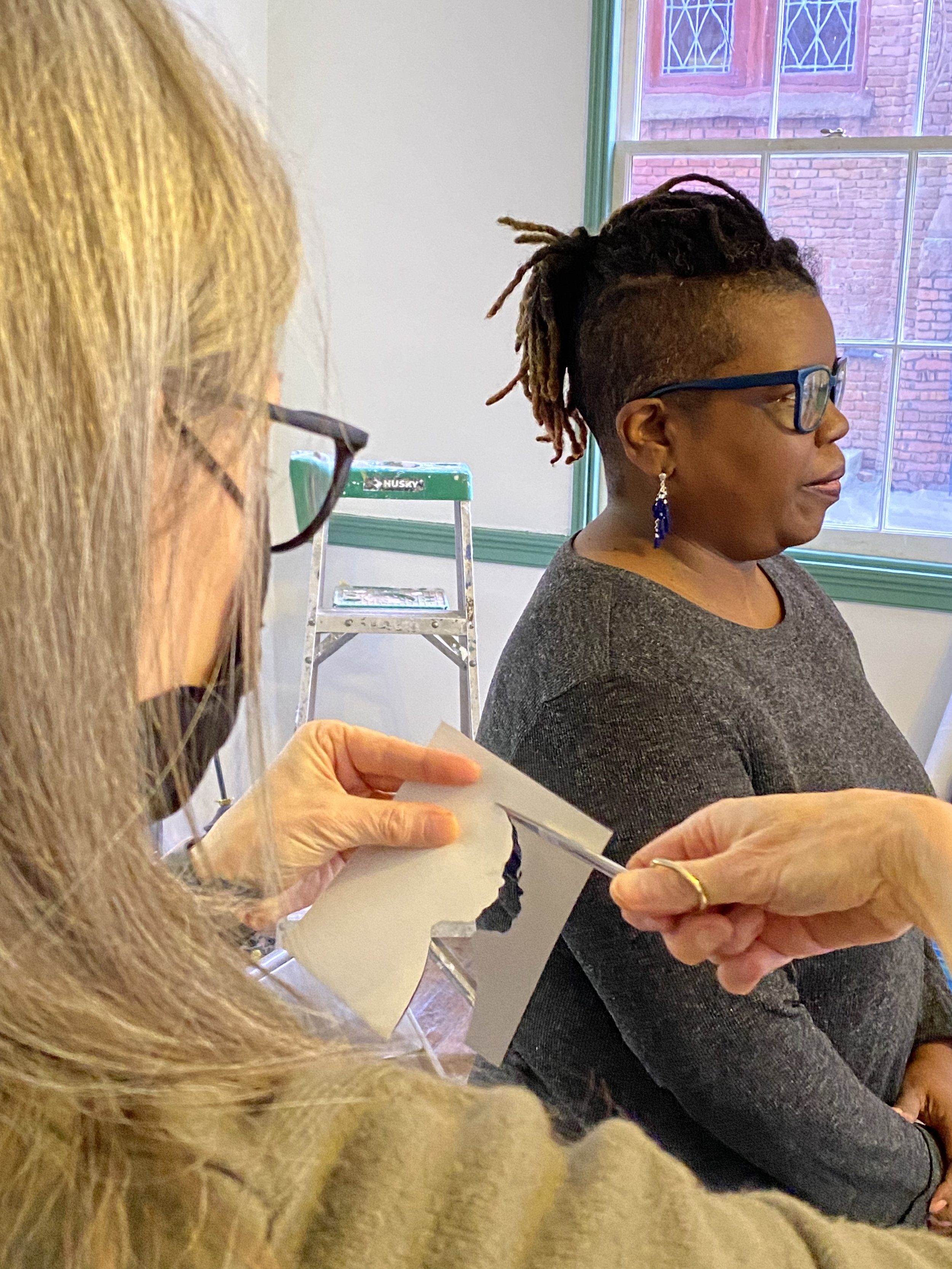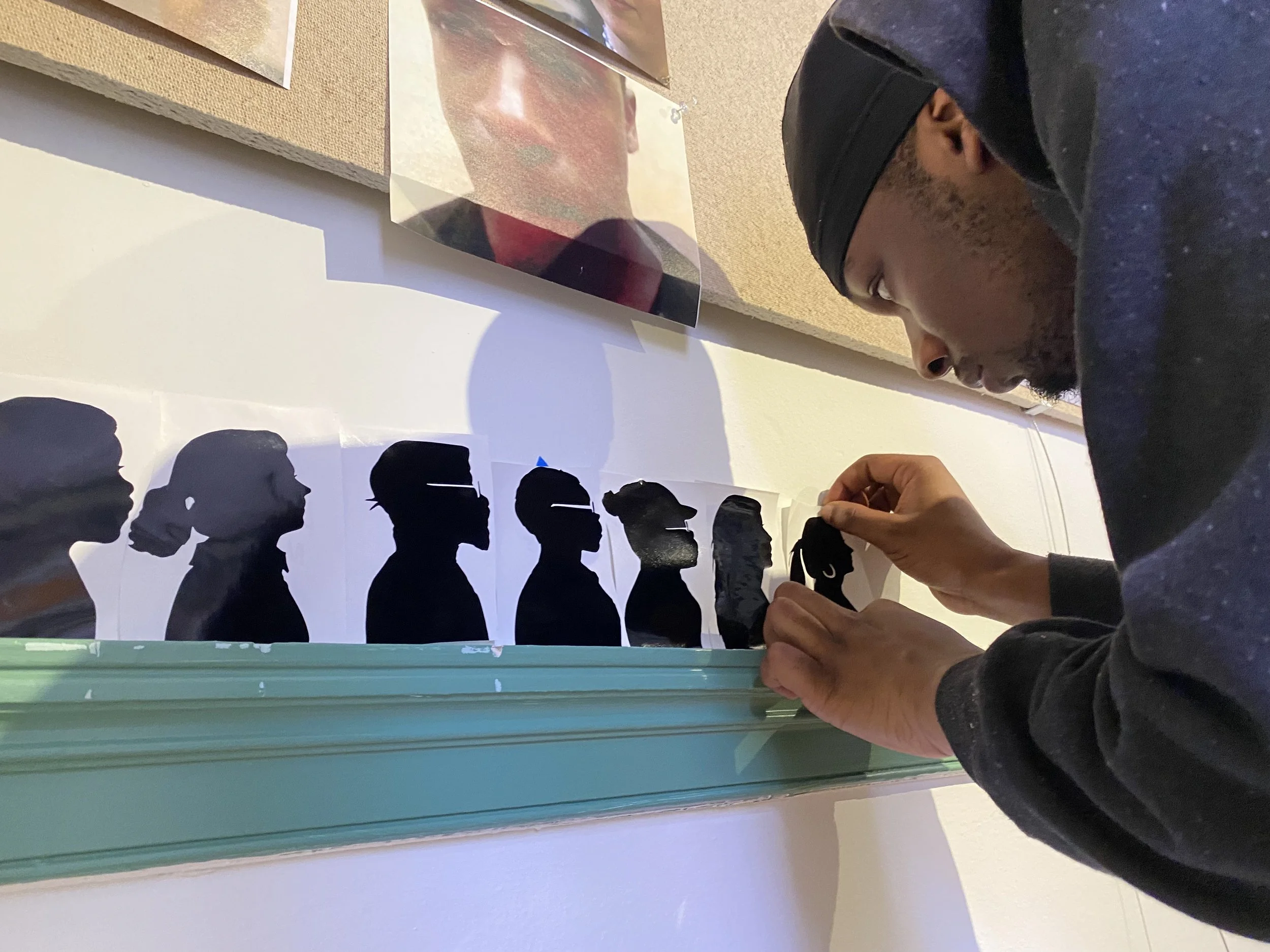The Peale Faces Project
Baltimore, Maryland USA
(c) Lauren Muney, 2019-2025.
“Your Face, Your Place in History”
The Peale in Baltimore celebrates Baltimore people and their stories - and now, their faces too.
Baltimore artist and participatory-history specialist Lauren Muney hand-created and installed custom silhouette (profile portraits) friezes of Baltimore City, Maryland residents silhouettes for long term, free public display at the Peale. The Peale is the first building built in the United States as a museum.
The Baltimore Connection
Baltimore has a long tradition of silhouettes, including being cut at the original Peale Museum starting in 1814. Silhouettes, by their nature, are a “democratic” portrait form. In the late 1700s, people underneath the richest citizens were discovering their own power: their power to work, earn money, and spend their money on how they wanted to present themselves.
Silhouettes are, by their nature, a portrait of the community. The Peale Center focuses on the history of Baltimore, its people, and their stories - including silhouettes. Through this public art project, the modern Peale Center presents Baltimore people and their histories for all to see and hear.
The Grand Project Vision
The grand vision of the installation includes public engagement as an inherent heart of the project. In each step, community members participate in the project.
Community members:
participate in their own historical-style silhouette portrait
receive their own silhouette to take home
have the opportunity to record their own personal story for Be Here Baltimore Stories,
toasted in the public presentation of almost 300 silhouettes of their friends, neighbors, and loved ones
Visitors have the ability to hear the audio stories of the people in the profiles on Smartify
Modern residents presented as a part of history
hese contemporary--but historical-style--portraits on historic walls will also allow community residents to visualize themselves as a part of history. For the public participants, it may be the first time they have sat for a portrait, or taken home an artist-made portrait of themselves. When the installation is completed, the sitters will see their faces honored and represented in a public place of historic and contemporary significance; representation is a powerful connection to self- and community-respect.
Photo of Lauren Muney taken at the Smithsonian Institution. Photo by Goodman Van Riper Photography.
The Experience of the “Sitters”
Participation in their own portrait
A silhouette “sitter” is the person who has his/her/their silhouette portrait made. In the past, silhouettes artists sat their customers in a chair. Silhouette portraiture (by an artist such as Lauren Muney) is so quick it can also be created while standing - but the customers are still called ‘sitters’ anyway.
Each person received his/her/their own portrait to take home. Each silhouette portrait was cut with scissors by hand, in the traditional manner of the early 1800s. For the public participants, it may be the first time they have sat for a portrait, or taken home an artist-made portrait of themselves.
History imprints back onto itself
To create the historical feel of the portraits being given to the sitters, artist Muney designed the participants’ experience to connect them back to the history of Baltimore itself. Baltimore in 1814 reflected the rest of the new United States - everything was made by hand.
Every silhouette given to the participants was mounted on a special background, designed by Lauren Muney based on an original design from the original Peale Museum in the 1800s. While the original Peale silhouettes didn’t use this background design, the original silhouettes had a background which was debossed (sunk into the paper) and did say “Peale”, “Museum”, or “Peale Museum”.
Historic St. Mary’s City in St. Mary’s City, MD, allowed special use of their reconstructed ca.1720 printing press to print these backgrounds of the silhouettes.
This style of press was still in use in Baltimore and neighboring areas during the early days of the Peale Museum. (see engraving image, at right) The press style is called a “Common Press”; HSMC’s press reconstructs the original press which stood in that spot in 1720, the second press in the American colonies (after Massachusetts).
This printing press’s prints- and the resulting image - is similar to silhouette experience at the original Peale Museum in the 19th century. Each silhouette sitter truly felt like they have had a truly historical experience, connecting to Maryland’s past in their modern hands. For people who didn’t know the history, they were intrigued by the background; the silhouette was their introduction to learning more about their city’s past.
The Experience of the Workers
Training the skilled workers of tomorrow
The physical installation was completed with the assistance of the Peale Center’s Accomplished Arts Apprentices, who are Baltimore youth learning professional skilled museum trades, are now connected them to the 19th century Black silhouette artist, Moses Williams, (portrait at right, from 1804) for whom the training center is named, and to the freedom and dignity of skilled trades.
The apprentices connected themselves with the history of portraiture in Baltimore and about the ingenuity of historic tradespeople and public. They mounted the “Peale faces” as they installed the portraits on the walls.
The Experience of the Visitors
The visitors will be viewing rooms of faces of their friends, loved ones, neighbors, and “unsung heroes” who have helped Baltimore become what it is today - a culturally rich, diverse, historical, and creative city. Because Baltimore is diverse in race, gender, age, economic status, employment, profession, and other factors, the walls show the magnificent diversity and also connection.
Accessible “Visual” Art
The silhouettes are slightly raised from the surface of the historical walls due to the vinyl final medium, so even visually impaired community members are able to feel the shapes of the silhouettes - to feel the shapes of the different faces.
Baltimore Stories
The Peale stewards the largest digital collection of Baltimore stories in the world about Baltimore: from neighborhoods and landmarks to social and environmental justice, education, local food, and more. Hear stories from around Baltimore and record your own on the Peale’s website or using the Free Be Here Stories App for iOS. Visit this link to learn more about Baltimore Stories, and this valuable oral history project in Baltimore.
See for yourself!
Come see the Peale Faces - almost 300 of them - on the walls at 225 Holiday Street, Baltimore MD .
This project is supported by the Maryland State Arts Council. Thank you, MSAC! For more information on the MSAC, please visit www.msac.org
The completed silhouettes at the Peale
The preparation for the silhouettes
Project Sponsors and Partners
Funders or providers of kind-kind donations











































